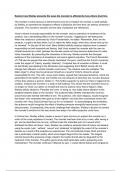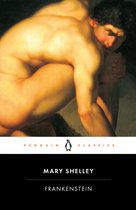Explore how Shelley presents the ways the monster is affected by how others treat him.
The monster’s entire persona is determined by how he is treated; the monster is used tactfully,
by Shelley, to represent the dangerous effects of prejudice and how they can destroy someone’s
character. The monster’s storyline and the idea of prejudice are intertwined.
Victor's refusal to accept responsibility for the monster, and by extension his treatment of the
creature, has a devastating effect on the monster’s psyche - triggering his self destruction.
When the creature is confronted by Victor Frankenstein, he states “Remember, that I am the
creature; I ought to be that Adam, but I’m rather thy fallen angel, whom thou drives from joy for
no misdeed”. In this part of the novel, Mary Shelley tactfully employs religious lexis to present
responsibility as both essential and freeing. Had Victor treated the monster with the care he
himself received as a child, perhaps the monster would not have become determined to make
Victor miserable. By presenting the characters in this way, Shelley reminds the Georgian
audience of the importance of acceptance and warns against prejudice. The French Revolution
of 1789 saw the people that were heavily mistreated, the poor, overthrow the French monarchy,
under the slogan of "Liberty, equality, fraternity". It inspired fear of revolution in Britain. It could
be that Shelly was alluding to the Revolution and suggesting that if British society did not
change their attitudes, a similar situation could occur. The creature uses the metaphor “the
fallen angel” to show how he perceives himself as a result of Victor's refusal to accept
responsibility for him. The critic, Joyce Carol Oates, argued that ‘repressed emotions, which are
personified in the Gothic novel, are horrible not only because of what they are, but also because
of how they enslave a person’ (Oates 1). This further supports my point as Victor’s neglect of his
creation, enslaves the monster in a state of self loathing. This shows that the monster's focus is
no longer on Victor, but rather on himself and how his actions mirror that of Satan’s. Mary
Shelley artfully alludes to ‘Paradise lost’ here. In doing so, she subtly draws attention to the
parallels between Satan in the monster. The audience Mary Shelley intended this novel for,
would have been familiar with Milton’s text. The audience, who were religious, would recognise
that Satan “who contended with gods to sit the highest“ and was then constrained mirrors the
monster who “thou [Victor] drivest from joy for no misdeeds”. In acknowledging the similarities,
the audience would recognise the effect of treating someone wrongfully based purely on their
idiosyncrasies. Consequently, they would challenge their attitudes. Shelley’s decision to present
the monster's emotions in this way shows how deep of an affect prejudice could have.
In Volume two, Shelley artfully creates a sense of pain and envy to present the monster as a
victim of the cruel prejudices of society. The monster had been shot at by a man, after saving a
girl, and he describes how he now, ‘writhed under the miserable pain of a wound which
shattered the flesh and bone’. Here, Shelley has created a semantic field of torture and ailment,
using the words ‘pain’, ‘writhed’, ‘wound’ and ‘shattered’ to highlight the extent of the monster’s
despair as a result of the prejudice he experienced. The conventional phrase ‘flesh and bone’
has a particularly visceral quality, which encourages disgust from the reader. The disgust
extends beyond the gruesome image created; the reader should also be disgusted by the
treatment of the monster. The gothic genre lends itself particularly well to presenting such
mistreatment. The monster continues ‘Inflamed by pain, I vowed eternal hatred and vengeance





